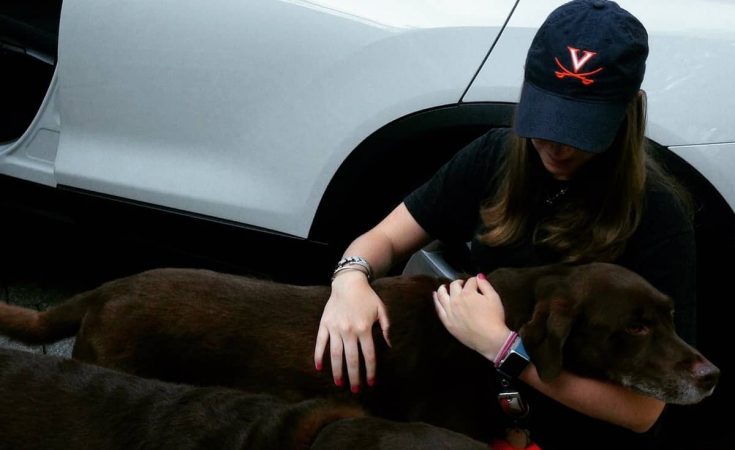Saying goodbye to our college daughter on the steps of her freshman dorm last fall was a moment marked with a long hug, a few tears and a dollop of heartache. This semester, she will have a car at college and my anguish will begin when we say our goodbyes and not diminish until we get the text from her with that beautiful 4-letter word, “here.”

How to help your teen prepare for a safe drive back to college
Note: We receive compensation from purchases made through some of these links.
After the terrible 24-hour shut down on I95 this winter, and thinking about the potential for other roadside emergencies, these tips and supplies are even more urgent. Many of these safety devices are inexpensive and will provide more peace of mind knowing your teen will be prepared for unexpected weather, a breakdown, or an accident on the road.
In the Trunk
1. Jumper cables
A dead battery is a relatively easy fix with a set of jumper cables and the knowledge of how to use them. A step-by-step guide on the safe way to jump-start a car can be found here. Consider printing them out, reviewing them with your teen, and folding them into the glove box where they can find them when they need them.
One other way to help start a dead battery is to invest in this compact portable battery charging device that has great safety features. It makes the entire process so much easier than conventional charger cables since no other car is required to jump the dead battery. The sturdy clamps won’t allow you to jump-start the car unless properly attached.
2. Reflector triangles
Being visible is crucial if a car is broken down on the side of the road and a reflector triangle in the trunk could be invaluable.
3. Carjack
Make sure it is a compatible size for the car.
Thorough there may not be snow on the ground when your teen drives back to school, go ahead and get them ready for snow and ice.
In the Car
5. Phone car charger
Having a fully charged cell phone to call for help could be a lifesaver making a car charger is a true college essential. This one gets top reviews, can charge phones, tablets, and computers with both USB-C and USB-A ports.
6. E‑ZPass
A time saver and great convenience on toll roads in 19 states in the eastern part of the US, an E‑ZPass device mounted on the front windshield of the car will save your teen time and money if they travel on tool roads.
Holding a phone while looking at directions or glancing to read a text is dangerous and could result in a ticket, too. This popular dashboard mount gets top reviews and solves the problem.
Auto Check-Up
We found these tips from the National Safety Council but also recommend scheduling an appointment with a mechanic for a pre-road check. Start the drive with a full tank of gas.
8. Tires
Check for proper inflation, alignment, and tread. Have they been rotated according to the recommended tire rotation schedule?
9. Wiper Blades
Still working or is it time to replace?
10. Fluids
Battery fluid, brake fluid, coolant, oil, transmission fluid, windshield wiper fluid all need to be at proper levels.
11. Lights
Brake lights, headlights, turn signals should be checked.
12. Belts and hoses
Look for cracks or bulges; if over four years old, they need to be replaced.
In Case of Emergency
If your teen feels that they are losing power, hears an unfamiliar sound, or has a tire blow-out, here’s what to do. Go through these five points with your teen well before he is packed and ready to go.
13. Slow down
Your teen should resist the urge to slam on the brakes and should, instead, gradually decrease speed.
14. Use the indicators
Indicators and hazard lights will show others what the driver is trying to do. Make sure your teen knows where these buttons are.
15. Be seen
After driving to a safe spot off the highway, keep the flashers going, raise the hood, and place a reflector triangle behind the car, especially if this occurs during the night.
16. Call for help
Your teen should take note of any highway signs or landmarks to give emergency responders an idea of where they are stranded.
17. Stay away from the road
Remind your teen to never walk in the road, even to get tools or supplies out of the trunk, but should slide over and get out of the car on the passenger side. Further, they should stand far away from the car while waiting for help.
In the Glovebox
18. Roadside assistance
Who should your teen call if they have car trouble on the road? While they will want to phone you for help, they need to know who to call for roadside assistance. Options may include the family insurance provider, AAA, or, possibly, the manufacturer of the car.
Take time, before your teen leaves for college, to explore which will be most responsive. Make sure they have the number in the car and a fully charged cell phone.
19. Ownership documents
If your teen is pulled over or needs the help of the police, they will need the registration and insurance card along with a valid driver’s license. Do they know where each of these is kept?
20. Owner’s Manual
A wealth of information about the recommended operation of the car, this is one reference book that they need to refer to while operating the car.
21. Accident report
In case your teen is involved in an accident, would they know what information to collect from another driver?
After calling the police and 911 if anyone is hurt, collect contact information, driver’s license number, insurance policy account, and phone numbers and while standing at a safe spot near the scene. Take pictures of any damage to your car and their car, too.
In the Backseat
22. Water and non-perishable snacks
23. Compact first aid kit

24. Blanket and warm clothes
If your teen is driving in a cold climate, make sure they have a hat, gloves, and a jacket.
25. Flashlight and extra batteries
One final thought, my favorite app to use for navigation is Waze. After loading in the destination address, Waze will offer several different routes and expected arrival times. It will alert drivers to accidents or hazards along the way, too. This is a great help for your teen to drive safely back to college.
Learn more about teen driving and how to help them become safer drivers.
SaveSaveSaveSave
SaveSave
SaveSave








































